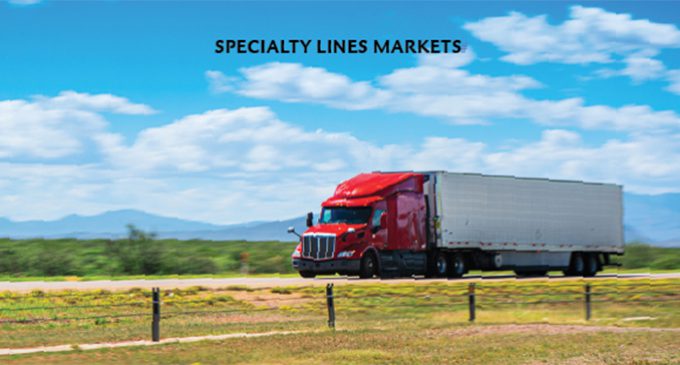COMMERCIAL AUTO AND TRUCKING

COMMERCIAL AUTO AND TRUCKING SEARCHES FOR SOLID GROUND
Driver shortages prove significant in terms of claim losses
By Lori Widmer
In 2018, the trucking industry had over 60,000 job openings for drivers, says the American Trucking Associations (ATA). By 2021, that number had climbed to 80,000.
The impact of the driver shortage on the commercial auto and trucking industry is proving to be significant in terms of claim losses. A report by CNBC revealed that jury awards for accidents involving commercial trucks jumped nearly 1,000% from 2010 to2018. Most notable was a case in Nassau County, Florida, in which the jury awarded $1 billion to the family of a college student who was killed when an unlicensed truck driver caused a fatal accident.
Such verdicts are causing more than a little consternation within the insurance industry. While not all segments of the industry have been hit with large settlements, the possibility has underwriters proceeding cautiously, creating confusion at renewal time. “Commercial auto, including the entire transportation segment (i.e., long-haul trucking, last-mile delivery) can be a challenging industry for insureds across the board,” says Joy LaFrance, chief underwriting officer for One80 Intermediaries. “While there are plenty of insurance carriers, reinsurers, fronting arrangements, and risk retention groups, not all options are created equal in this space.”

“Automotive hacking, data and privacy breaches, as well as insureds’ data being held for ransom, have all impacted the commercial auto space.”
—Joy LaFrance
Chief Underwriting Officer
One80 Intermediaries
LaFrance says that while new pro-ducts are being unveiled, looks can be deceiving. “Some are strictly technology focused while others are still managed through traditional rating and underwriting.”
The issue, she says, is that from a pricing and coverage perspective, “there is little consistency from market to market or class to class. Further, not all underwriters understand the

Nick Saeger
independent contractors’ exposures in the transportation industry; improper underwriting ends up harming the motor carrier and the insurance carrier.”
Pricing and market health
Nick Saeger, assistant vice president of Transportation Products and Pricing for Sentry Insurance, says that while new products or coverages aren’t plentiful, insurers are teaming with insureds to tackle the risks. “I’ve seen insurers and insureds alike express interest in risk sharing. In particular, insureds have been more willing to take on larger deductibles to defray some upfront costs and share risk with their insurance companies. This is a great tactic for safety conscious customers whose experience profile is stronger than the typical insured,” Saeger says.
“Most programs and products that I have reviewed recently are taking between 15% to 25% increases on auto liability,” says LaFrance. “Recent years’(2019-2021) performance has under-performed relative to the ultimate loss ratios set by most products/policies/programs in this marketplace.”
And here’s why. According to Saeger, the auto physical damage sector on both personal and commercial lines “postedits four worst quarters in the last 20 years. For liability, there is a sense that litigation financing (outside investment in attorneys and/or individual cases, encouraging and allowing attorneys to take cases to trial and press for larger settlements) is growing, but there just isn’t a great way to determine the impact.”
All of this, Saeger points out, is contributing to escalating premiums. So, too, are other factors. “On the physical damage side, in the last 12 months(give or take), supply chain constraints have led to significant economic inflation,” Saeger says. “The scarcity of both parts and vehicles has driven up costs for vehicle repair and replacement.”

Mark Gallagher
Still, Mark Gallagher says, the transportation market is still quite viable and holds much opportunity. “Demand for transportation services remain strong. The U.S. economy continues to grow. And there’s a lot of freight that’s being moved across the country.”
However, Gallagher, vice president and national Transportation Practice leader for Risk Placement Services (RPS), says there are significant headwinds that the industry must face, including increasing equipment costs, driver shortages, and claim costs. Customers who have lower safety scores and loss deterioration will face higher claims costs and higher insurance costs, he adds.
“There are some significant claims drivers out there, insurers are struggling with social inflation, and nuclear verdicts are being fueled by rising medical costs and higher levels of litigation,” says Gallagher. “For transportation clients, they are also concerned that they’re coming under increased scrutiny every time a loss occurs.”
Another cost driver? “Drivers, drivers, and drivers,” says LaFrance. “With driver and employee shortages throughout the country, insureds are accepting less experienced drivers with a limited driving history. Overall driver shortage is forcing insureds to make a choice between hiring drivers who strictly fit the insureds’ rules, regulations, and requirements (at the risk of not having adequate staff) or loosening hiring requirements and post-hire driver quality control.”
As a result, drivers without the required training or back-ground are being hired, says LaFrance. “The inability for insureds to make sure drivers complete comprehensive driver training, maintain adequate driver behavior scoring, and enforce the requirements of the insurance industry to improve underwriting results is very difficult.”
“There are some significant claims drivers out there, insurers are struggling with social inflation, and nuclear verdicts are being fueled by rising medical costs and higher levels of litigation.”
—Mark Gallagher
Vice President and National Transportation Practice Leader
The cyber impact
That’s where telematics and vehicle-based technology could help reduce claim costs and improve safety. However, even as technology is helping with safety and claims, it can also

Steve Robinson
expose a company to cyber threats. Steve Robinson, national Cyber Practice leader for Risk Placement Services, says that the trucking industry’s increased reliance on technology makes organizations vulnerable to cyberattacks. “They are essentially rolling computers equipped with transportation management systems, fleet routing systems, back office systems and reefer temperature monitoring systems—to name a few,” says Robinson. “All these networks house confidential information, and if threatened via a data breach or ransomware attack, it could disrupt not only the company’s operations but the entire supply chain.”
Not just the networks, but the vehicles attached to them could be exposed, says Colby Waltenburg, president of Transatlantic Underwriters (TAU). “With the push for autonomous vehicles, I anticipate this is something all agents will need to have on their radar in the near future.”
“Automotive hacking, data and privacy breaches, as well as insureds’ data being held for ransom, have all impacted the commercial auto space,”says LaFrance. “Potential automotive network hacking, including both logistics delivery and route management, as well as over-the-air fleet management, could be dangerous to the safety of drivers and/or passengers; hacking automobile key fobs or systems can have extreme consequences to the insured, the public and the insurance industry.”
The larger issue, LaFrance says, is how claims will be handled. “Who will be responsible for these claims is going to be the ultimate concern when our industry has rated, underwritten and educated our agents/brokers and insureds/drivers on how to improve their behavior. If a vehicle or system is hacked, that isn’t contemplated in the underwriting of an account.”
Reducing costs

Colby Waltenburg
Even with such myriad risk exposures, there are segments of the market that are showing signs of recovery. In the commercial auto realm, Waltenburg has seen competition heat up. “Commercial auto, specifically the trucking-for-hire market, is starting to get very competitive. After years of rate increases, stricter guide-lines, and a constricting of appetite by insurance companies, the market has started to turn. While capacity in London no longer seems to be an issue, domestic carriers are seeking growth and market share.”
That willingness to take on the commercial auto and trucking risks could be credited in part to the rise of both insurtech and telematics. Waltenburg says that some companies are “going full insurtech—almost completely forgoing the traditional underwriting process in favor of data, predictive modeling, and analytics. These steps, in theory, should allow trucking companies to identify risky driver behavior and provide coaching to help prevent potential future claims.”
So, too, could the use of telematics improve safety. The absence of telematics is an emerging claim driver, says Doug Betkowski, senior vice president and Transportation Practice lead-er of the Major Case Unit at Gallagher Bassett Specialty. “The use of new technology in the cab and around the truck have recently been the focus of the plaintiff’s bar, when recording devices and accident-avoidance technology records are not available and/or malfunction. Claims of spoliation of evidence usually follow and create extensive and expensive litigation.”
When organizations use telematics, their claims settlements stand a much better chance of being settled quickly and possibly more reasonably from a financial standpoint. Michael

Michael Teng
Teng, assistant vice president of Regional Products, Pricing and Underwriting for Sentry Insurance, says that a continued focus on driver behavior and training helps with reducing those claims costs. “Good behaviors should always be enforced: no cell phone usage while driving, adequate rest over long-distance driving, no drinking before driving, etc. Help business owners develop and implement driving best practices,” says Teng.
Advice for agents and brokers
Though cameras will help, avoiding accidents is the goal. Betkowski says companies should be implementing driver training and safety. “Safety needs to be one of the top priorities throughout the organization and it needs to resonate with every member of the organization,” Betkowski says.
Some of that help can come from carriers, says Gallagher. “Many carriers are providing camera subsidies for outward-and inward-facing cameras.” Gallagher says a few carriers are offering cameras for free to their customers and also considering credits when telematics data is shared by trucking clients.

Doug Betkowski
That level of awareness is exactly what agents and brokers need to achieve in order to successfully serve their commercial transportation customers, says Waltenburg. “If you’re going to write commercial auto and trucking, you need to be all in. The retail agent, wholesaler, MGA, and company all need to have dedicated professionals who do nothing but commercial auto and trucking.”
That’s going to build trust and help both insureds and carriers know the relationship with the agent or broker is strong. “The relationship between agent/insured must be built on honesty and transparency,” says LaFrance. “Agents should consider the quality of each insured when deciding to partner and offer their services. The agent/carrier relationship could be challenged if any sense of being misled (even by accident) is suspected.”
The more the agent or broker knows about the industry, says Gallagher, the less likely it is that insureds will feel misled. But it takes focus and dedication, he says. “Get involved in state and national associations that offer opportunities for education and networking. And stay on top of the latest news and trends by regularly reading industry publications and reports (such as the RPS 2022 U.S. Transportation Market Outlook).
“Staying up on the latest developments within our great industry allows you to be the transportation expert that clients will turn to,” he concludes.
For more information:
Gallagher Bassett Specialty
www.gallagherbassett.com
One80 Intermediaries
www.one80intermediaries.com
Risk Placement Services
www.rpsins.com
Sentry Insurance
www.sentry.com
Transatlantic Underwriters
www.tau-usa.com
The author
Lori Widmer is a Philadelphia-based writer and editor who specializes in insurance and risk management











